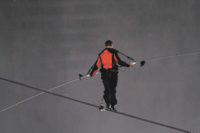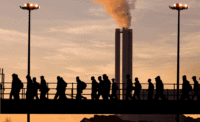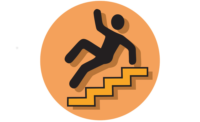 Question: We are looking to install a temporary horizontal lifeline system in our theatre. It is outdoors so we are would prefer the line to be galvanized aircraft cable instead of synthetic rope. The run would be roughly 40 feet long. We were wondering if the use of rated aircraft cable and hardware along with the correct anchorage points would be safe and meet the necessary standards.
Question: We are looking to install a temporary horizontal lifeline system in our theatre. It is outdoors so we are would prefer the line to be galvanized aircraft cable instead of synthetic rope. The run would be roughly 40 feet long. We were wondering if the use of rated aircraft cable and hardware along with the correct anchorage points would be safe and meet the necessary standards.
Answer: As far as component types are concerned. There will be less stretch so less fall distance and reduce collisions so that is good. But the real question is what is the fall protection system are you intending 5/16” or 3/8” dia. aircraft cable and swaged terminations, and then what is the application involving how many people? Are you attaching SRL’s or lanyards and what hardware is being used such as large snaphooks compliant with Z359.1-2007 with 3600 lbs gates and are you using shackles attached to an anchorage capable of 16,000 lbs.
Question: How do you rig fall protection where there is no access between HVAC, Conduit and 40 ft above?
Answer: The question is how to approach a cable tray filled with conduit also the HVAC unit when there is no obvious anchor point. HVAC unit and trapeze hold the cable tray. Assume that the cable tray is 15 ft above the ground. In this case inside a building there are numerous types of aerial lift to access and where the lift can provide an anchor for in-the-bucket work above head height Above a corridor drop ceiling, we can access the area by catwalk then build a scaffold for certain types of work. Voltages unknown and if electric can be shut down. Frequency of work unknown. Duration of work unknown. Specific work and work method unknown. Number in crew unknown. Can a HLL be placed up to 40 ft up? EFSS can engineer that if requested for the people specified.
Question: I have run across several contractors using rigging (cable chokers, nylon slings) for fall protection. Either by hanging retractable lanyards from them or tying off to them directly. What is the proper answer? I believe that rigging is for material handling and that's all. They make D-ring straps for these applications.
Answer: Use of material slings is a good idea for anchorage connectors when:
1. They are committed for fall arrest application only with strength exceeding OSHA requirements when new.
2. They are permanently marked as to purpose (never any mixed use).
3. They are permanently labeled for fall arrest use only per Z359 2007 Fall Protection Code.
4. The connection to the fall arrest connector is compatible per manufacturer's instructions, also see 9.
5. The attachment to the anchorage is compatible and not cutting, and choking is acceptable per manufacturer's instructions.
6. The sling is part of an approved fall arrest system endorsed by a Competent Person and a Qualified Person compliant with 1926.32 and 1926.500 series.
7. The sling is inspected regularly for damage and replaced when necessary with another sling meeting items 1-6.
8. The sling is polyester in acid environments; wire cable in abrasive environments.
9. The application has been reviewed for possible vibration damage over a few months period of time.
10. Portable applications are treated as a system with approved anchorage meeting 1926.500 series or equivalent for 1910 applications.
11. Choose a fall equipment manufacturer's sling with D-ring and loop for choking preferably if the above conditions 1-10 are met.
Note: Watch for revised and new ANSI Z359.0-4 in the next year.
Question: What sort of fall protection system or program is required for workers that spend 4 hours or more on a platform every two weeks?
Answer: This is controlled by OSHA Instruction 01-01-013 that indicates a guardrail is necessary for work less than 4 hours, an alternative fall protection system is OK. Use of the proposed general industry standard dated 4/10/90 would be acceptable. Washington State has a connection to the equivalent of 1910.66 App. C (soon to beome a horizontal standard in that state, like ladders). You also can use 1910.66 App. C as policy.
Fall protection FAQs

Looking for a reprint of this article?
From high-res PDFs to custom plaques, order your copy today!






